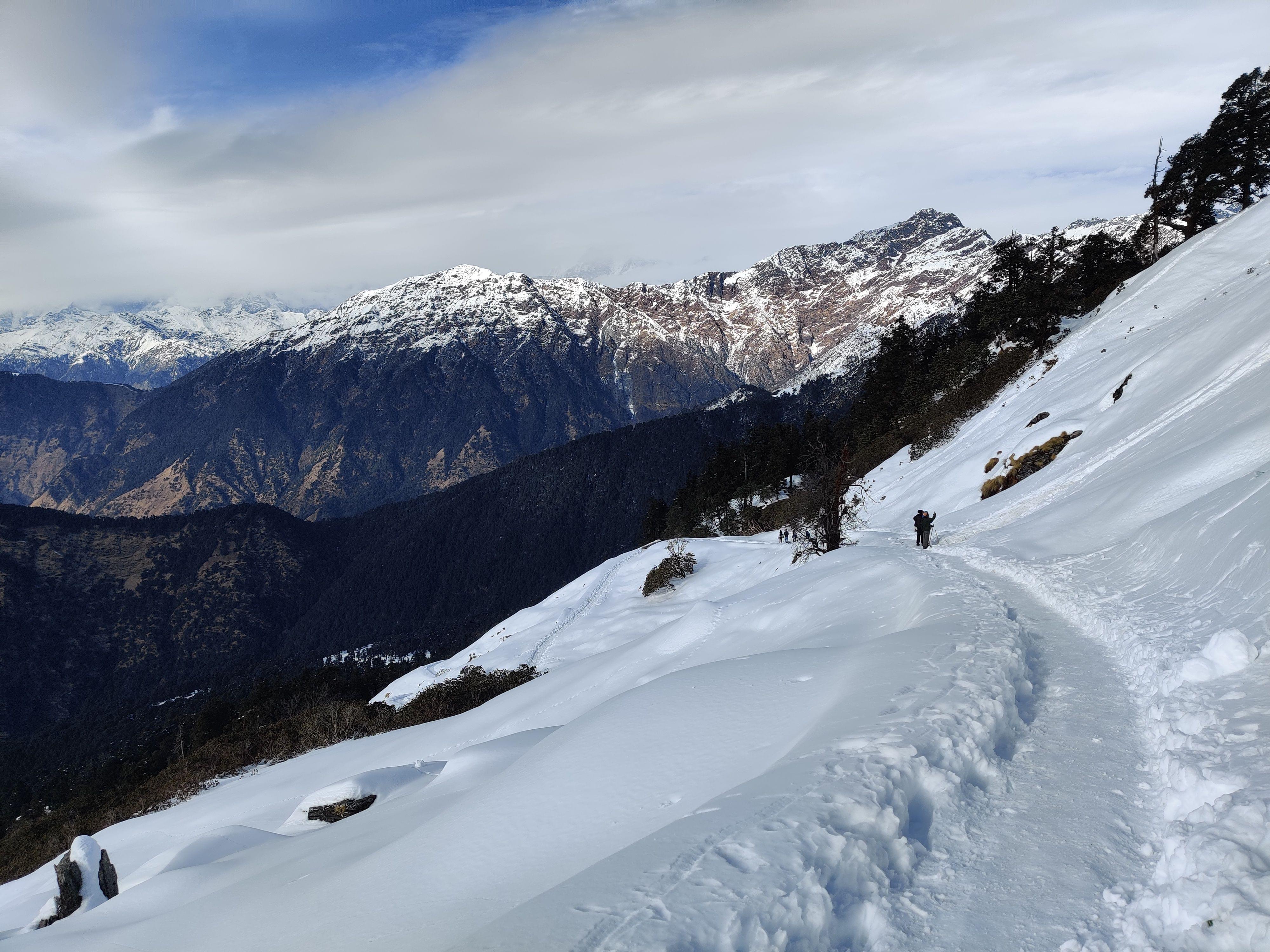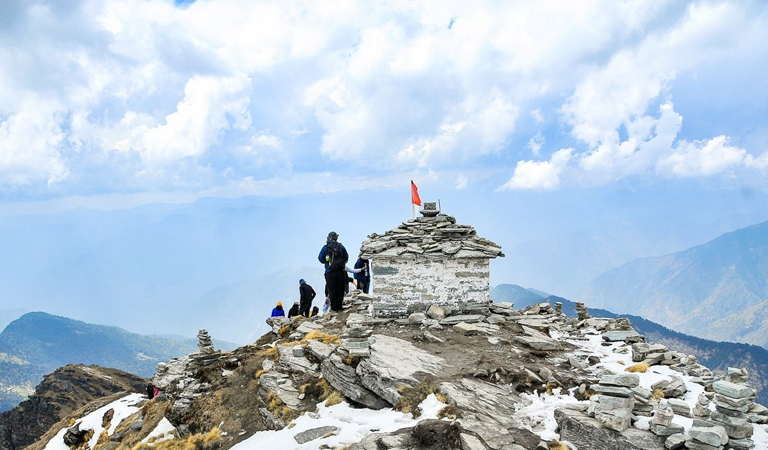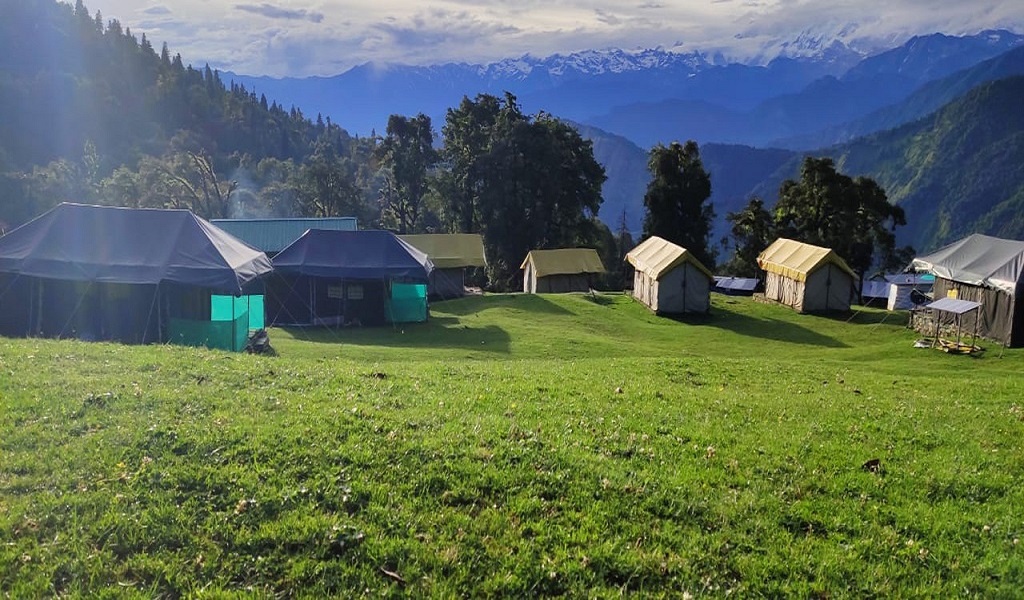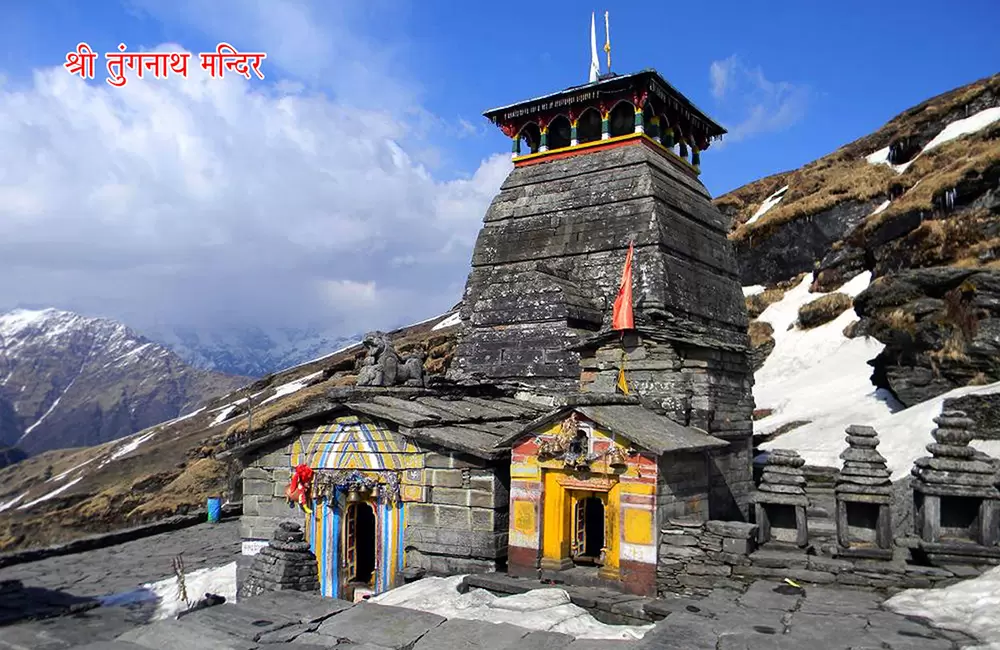Where Earth Meets the Sky: Chopta Tungnath Trek from Delhi
Published on June 20, 2025
Chopta Tungnath Trek from Delhi, Looking for a break from Delhi’s chaos? The Chopta Tungnath Trek from Delhi is more than just a weekend getaway — it's a soulful journey through misty forests, sacred trails, and mountain summits that touch the sky. Whether you're seeking inner peace, mountain adventure, or the perfect couple retreat, our Chopta tour packages are crafted to give you everything you're looking for — and more.
Sample 3-Day Chopta Tungnath Trek Itinerary
Day 0: Delhi to Rishikesh to Sari Village
- Departure: Start your journey from Botanical Garden Metro Station at 10:00 PM.
- Overnight Journey: Travel overnight towards Sari Village via Rishikesh.
- Stop at Devprayag: Witness the mesmerizing confluence of the Bhagirathi and Alaknanda rivers along the way.
Day 1: Sari Village to Deoriatal
- Arrival at Sari Village: Check into your homestay and take some time to freshen up.
- Trek to Deoriatal: Begin your trek to Deoriatal (2.5 km, approximately 1.5–2 hours).
- Enjoy Deoriatal: Soak in the serene beauty of the lake and the surrounding landscapes.
- Return to Sari Village: Head back to Sari Village and enjoy a peaceful evening.
Day 2: Sari Village to Tungnath & Chandrashila
- Breakfast: Start your day with a hearty breakfast at your homestay.
- Drive to Chopta: A scenic drive of about 1 hour from Sari Village.
- Trek to Tungnath Temple: Embark on a 3.5 km trek to the sacred Tungnath Temple.
- Summit Chandrashila: Extend your trek by 1.5 km to reach the breathtaking Chandrashila summit.
- Return to Chopta/Sari: After the trek, return to Chopta or Sari for an overnight stay at the campsite.
Day 3: Chopta to Delhi
- Breakfast: Enjoy an early breakfast at your campsite in Chopta.
- Departure: Begin your journey back to Delhi in the early morning.
- Visit Dhari Devi Temple: Stop by the revered Dhari Devi Temple en route.
- Arrival in Delhi: A long drive of approximately 10–12 hours marks the end of your adventure.

Why Chopta? The Basecamp to the Gods
Chopta, known as the “Mini Switzerland of India,” is the base for the Tungnath Temple Trek and the Chandrashila Summit Trek. Surrounded by lush deodar and rhododendron forests, this peaceful hamlet lies at 2,680 meters and is a nature-lover’s dream.
With Chopta tour package from Delhi, you’ll enjoy breathtaking Himalayan views, crisp mountain air, cozy camps, and thrilling treks.
Chopta Tungnath Trek: A Sacred Climb
The Tungnath trek distance is just 3.5 km but offers a deeply spiritual experience. Tungnath is the highest Shiva temple in the world, perched at 3,680 meters. The trail is short, scenic, and suitable for beginners.
✔️ Ideal for solo travelers, spiritual seekers, and first-time trekkers
✔️ Included in all Tungnath trek package from Rishikesh, Haridwar, and Dehradun
✔️ Tungnath trip cost starts from ₹4,999 with meals, guide, and stay
Chandrashila Trek: Touching the Sky
Continue the trail from Tungnath to reach Chandrashila, the summit at 4,000 meters. The Chandrashila trek rewards you with panoramic views of Nanda Devi, Chaukhamba, Trishul, and Kedarnath.
Chopta Chandrashila trek distance: ~5 km
Best time to visit: March–June & October–December
Chopta Chandrashila trek from Delhi cost: ₹5,500–₹10,000
Popular plan: Chopta Chandrashila trek 3 days itinerary
How to Reach: Chopta Tour Package from Delhi & More
Choose from our seamless travel options:
-
Chopta tour package from Delhi – Includes AC travel, meals, trek guide, and stay
-
Chopta tour package from Haridwar – Ideal for spiritual & short trips
-
Tungnath trek package from Rishikesh – Adventure-focused itineraries
-
Tungnath package from Dehradun – Relaxed and premium tours for families & couples
Our Chopta Tungnath trek package ensures comfort, safety, and a rich Himalayan experience.

Inclusions & Highlights
✅ Delhi to Chopta transport (AC/NAC options)
✅ Stay in camps/cottages (double/triple sharing)
✅ Breakfast + Dinner
✅ Certified local guide for Tungnath & Chandrashila treks
✅ Permits and bonfire (where applicable)
Chopta Tour Package for Couples
Planning a romantic Himalayan escape? Our Chopta tour package for couples offers:
-
Private stays in wooden cottages or luxury tents
-
Guided treks to Tungnath Temple & Chandrashila
-
Candlelight dinner under the stars (optional)
-
Bonfire, photography, and serene mountain walks
Flora & Fauna Along the Trek
As you trek, witness stunning Himalayan biodiversity — rhododendron forests, deodar trees, and wildlife like the Himalayan Monal, musk deer, and foxes. The Chopta Chandrashila trek is also a dream for birdwatchers and nature photographers.
Who Is This Trek For?
-
Winter Wanderers: Snow-covered Tungnath temple trek (Dec–Feb)
-
Spring Seekers: Buransh flowers in full bloom (Mar–Apr)
-
Beginner Trekkers: Gentle slopes, short distances, huge rewards
-
Couples: Peaceful, picturesque, and private stays

Whispers of the Wind: Weather Wonders of Chopta Tungnath
Perched high in the Garhwal Himalayas, the weather of Chopta Tungnath is as enchanting as its trails. From golden sunrises over snowy peaks to misty forests and crisp air, each season paints a different picture — making it a dream destination for trekkers, nature lovers, and peace seekers alike. Whether you're planning the Chopta Tungnath trek or a spiritual journey to the Tungnath Temple, understanding the weather is key to crafting a perfect mountain escape.
Spring (March to April): Bloom & Bliss
-
Temperature: 8°C to 18°C
-
Weather: Pleasant days and cool nights
-
Experience: Forests burst into color with blooming Buransh (rhododendrons), and trails are dry and welcoming. Ideal for photography and light trekking.
-
Perfect for: Beginners, couples, and nature lovers
Summer (May to June): Clear Skies & Himalayan Highs
-
Temperature: 10°C to 22°C
-
Weather: Bright days, clear skies, cool evenings
-
Experience: The best visibility of snow-clad peaks. The Chopta Tungnath trek and Chandrashila summit trek are at their safest.
-
Perfect for: Trekking, camping, bird watching, group tours
Monsoon (July to September): Misty Magic & Green Glory
-
Temperature: 10°C to 16°C
-
Weather: Frequent rainfall, fog, and wet trails
-
Experience: Forests turn lush and mystical, but trekking becomes risky due to slippery paths and landslides.
-
Perfect for: Peaceful stays, nature photography, offbeat travel (avoid for trekking)
Autumn (October to November): Crisp Air & Golden Trails
-
Temperature: 5°C to 15°C
-
Weather: Chilly mornings, clear skies, and calm winds
-
Experience: A perfect trekking window. The post-monsoon greenery lingers while the peaks start preparing for winter.
-
Perfect for: Chopta Chandrashila trek, Tungnath temple trek, and sunrise views from the summit
Winter (December to February): Snow-Kissed Serenity
-
Temperature: -5°C to 10°C
-
Weather: Heavy snowfall, freezing temperatures, magical white landscapes
-
Experience: Chopta Tungnath trek from Delhi turns into a snow adventure. The temple may be closed, but the trek is unforgettable.
-
Perfect for: Snow lovers, adventure seekers, photographers
Quick Tips for Weather-Wise Travelers
-
Layer your clothing – Weather changes quickly
-
Waterproof trekking shoes – Especially important in monsoon & snow
-
Sunscreen & sunglasses – Even in snow, the UV is strong
-
Hot water & thermals – A must-have for winter treks

Where Dreams Rest: Cozy Accommodations in Chopta Tungnath
After a day of trekking through pine-scented trails, snowy ridges, and spiritual paths, Chopta welcomes you with peaceful stays nestled in the lap of nature. Whether you’re watching the stars from your tent or sipping tea beside a wooden cottage, the accommodations in Chopta Tungnath offer comfort, charm, and the kind of silence your soul craves.
With options ranging from budget camps to deluxe cottages, your stay in Chopta is more than just a bed — it's an experience that brings you closer to the Himalayas.
1. Alpine Tents Under the Stars
-
✅ For nature lovers and adventure seekers
-
Spacious, waterproof tents with cozy bedding
-
Ideal for groups, solo travelers, and budget treks
-
Common bonfire areas and open dining spaces
-
Uninterrupted stargazing on clear nights
2. Wooden Cottages with a View
-
✅ For couples and comfort seekers
-
Private rooms with attached bathrooms
-
Scenic views of forests and snow-capped peaks
-
Firewood heating (on request), cozy interiors
-
Ideal for peaceful getaways and honeymooners
3. Eco-Friendly Guesthouses & Homestays
-
✅ For cultural and slow travelers
-
Stay with local families, enjoy home-cooked meals
-
Experience Garhwali hospitality and lifestyle
-
Budget-friendly with basic facilities
-
Close to trail starting points
4. Winter-Ready Stays (Dec–Feb)
-
Heated blankets, hot water buckets, and snow-view windows
-
Ideal base for Chopta Chandrashila trek in winter
-
Camps closed during heavy snowfall; cottages recommended
Why Choose Our Stay Packages with TourMyHoliday?
✔️ Pre-checked, safe & hygienic stays
✔️ Meal plans included (veg + egg options)
✔️ Guided treks from your doorstep
✔️ Custom upgrades available (deluxe tents, honeymoon setups)
✔️ Included in every Chopta tour package from Delhi, Haridwar, or Rishikesh

History of Chopta Tungnath: Where Legends Walk with the Clouds
High in the Garhwal Himalayas of Uttarakhand lies a spiritual sanctuary and trekking paradise — Chopta Tungnath. While Chopta enchants with its serene meadows and alpine beauty, Tungnath—the world’s highest Shiva temple—whispers ancient tales of gods, penance, and pilgrimage. The region’s history is not just etched in stone and scriptures but also in the footsteps of countless sages, shepherds, and modern-day trekkers who seek something more than just altitude — they seek divinity, discovery, and peace.
In this in-depth journey through the history of Chopta Tungnath, we explore its mythological roots, historical significance, cultural connections, and modern-day relevance as a trekker’s paradise.
The Landscape: Nature’s Temple Before the Temples
Before diving into mythology, one must appreciate the geography that shaped the legend.
Chopta, often referred to as the "Mini Base Camp of the Himalayas", sits at around 2,680 meters. It is part of the Kedarnath Wildlife Sanctuary, rich in alpine vegetation, Himalayan birds, and scenic trails. It serves as the starting point for the Tungnath Temple Trek and the Chandrashila Summit Trek. The entire region is soaked in stillness, with green meadows in spring and thick snow carpets in winter.
The pristine landscape has made Chopta not only a favorite trekking destination but also a spiritual site long before the word “tourism” even existed.
The Legend of Tungnath: A Story from the Mahabharata
The history of Tungnath Temple is deeply woven into the epic of the Mahabharata.
After the Kurukshetra war, the Pandavas were burdened with guilt for killing their kin. To seek atonement and the blessings of Lord Shiva, they journeyed to the Himalayas. However, Lord Shiva, not willing to forgive them easily, disguised himself as a bull (Nandi) and disappeared underground.
When the Pandavas reached the Garhwal region, Bhima spotted a bull that seemed unusual. He tried to catch it, but the bull vanished into the ground. The bull’s body parts reappeared at five different places, which came to be known as the Panch Kedar:
-
Kedarnath – Hump
-
Tungnath – Arms
-
Rudranath – Face
-
Madhyamaheshwar – Navel
-
Kalpeshwar – Hair
Tungnath, the third temple in this spiritual circuit, is where Shiva’s arms emerged.
To honor Lord Shiva, the Pandavas built temples at these five sacred sites. This is how Tungnath Temple, sitting at an elevation of 3,680 meters, became an eternal shrine dedicated to penance and devotion.
Historical Significance Through the Ages
While the mythology of Tungnath is ancient, the physical temple is believed to have been built over 1,000 years ago, possibly during the Adi Shankaracharya era (8th–9th century CE). Adi Shankaracharya played a vital role in reviving Hindu pilgrimage circuits and is believed to have visited this region during his travels across the Himalayas.
The architectural style of Tungnath Temple reflects Katyuri influence — with stone structures, a curved dome, and minimal ornamentation, echoing the humility of Shiva himself.
Even in older times, pilgrims and ascetics trekked these high altitudes to meditate and pay homage, despite harsh terrain and weather. The path to Tungnath was once a part of ancient trade and spiritual routes connecting Kedarnath and Badrinath valleys.

Chopta: The Silent Guardian of the Sacred Trail
While the temple holds the spotlight, Chopta plays a quiet yet crucial role. Historically, Chopta served as a resting ground for shepherds, sages, and pilgrims. Its flat pastures and rich flora made it ideal for grazing cattle and camping.
The name "Chopta" is believed to have originated from "Chopra" or "Chaupata", meaning four-sided, possibly referring to the meadow surrounded by forests on all sides.
Before becoming popular with tourists, Chopta was visited primarily by:
-
Local villagers during their seasonal migrations
-
Pilgrims heading to Panch Kedar shrines
-
Botanists and spiritual seekers
-
Sadhus during Himalayan yatras
Even today, locals deeply revere Chopta as a place of peace and purity — where the silence itself feels sacred.
A Seat of Spiritual Energy
With its elevation, silence, and seclusion, Tungnath is considered a powerful spiritual point for meditation and penance. Several yogis and saints, including the Nath yogis and Himalayan monks, are said to have meditated in and around this region.
The Chandrashila Summit, located above Tungnath at 4,000 meters, literally means “Moon Rock.” It is believed that Lord Rama meditated here after defeating Ravana, and the moon god Chandra also performed penance at this very summit.
Today, many modern spiritual seekers, yoga practitioners, and energy healers visit Chopta not just for trekking but for silent retreats and Himalayan meditation sessions.
Modern Revival: From Sacred Trail to Trekker’s Paradise
The early 2000s marked a shift in the identity of Chopta Tungnath — from an isolated pilgrimage path to a popular trekking destination. Thanks to the rise of eco-tourism and adventure travel, more trekkers began exploring this trail for its accessibility and beauty.
Key reasons for popularity:
-
Short trek: Ideal for beginners, families, and weekend travelers
-
Snow trek option: Winter Chopta Tungnath treks became Instagram favorites
-
Spiritual + Scenic: Few treks offer both like this one
-
Great accessibility: Routes from Delhi, Haridwar, Rishikesh, and Dehradun
Today, the Chopta Chandrashila Trek is one of the most recommended treks for both beginners and seasoned adventurers.
The Trekking Experience Today
A journey to Tungnath is more than just a hike — it’s a blend of:
-
Mythology – Walking the same path the Pandavas once took
-
Nature – Crossing meadows, forests, and snowy stretches
-
Spirituality – Reaching the abode of Shiva at the highest point
-
Adventure – Ascending to Chandrashila Summit for 360° Himalayan views
With Chopta tour packages from Delhi, Rishikesh, and Haridwar, visitors can now experience this blend of ancient legend and modern exploration in just 3–4 days.
Interesting Facts About Chopta Tungnath
-
Tungnath is the highest Shiva temple in the world at 3,680 meters.
-
The region is part of the Kedarnath Wildlife Sanctuary, rich in Himalayan biodiversity.
-
Chandrashila offers views of Nanda Devi, Chaukhamba, Trishul, and Kedarnath peaks.
-
The region is snow-covered between December and March, ideal for snow treks.
-
The temple is over 1,000 years old and still holds daily worship rituals.

Final Thoughts: A Trail Through Time
The history of Chopta Tungnath trek is not just carved in ancient stones — it's alive in the wind, whispered by the pines, echoed in the chants of trekkers, and lived by every traveler who sets foot on its sacred paths. It's where earth meets the sky, where divinity meets adventure, and where the past holds hands with the present.
Whether you're a trekker, a pilgrim, or a curious soul, the journey to Chopta Tungnath is one you’ll carry in your heart forever.
Frequently Asked Questions:
1. What is the historical significance of Tungnath Temple?
Tungnath is believed to be over 1,000 years old and is one of the Panch Kedar temples, where Lord Shiva’s arms appeared after disappearing from the Pandavas.
2. Why is Chopta called the 'Mini Switzerland of India'?
Chopta is often called that due to its lush green meadows, snow-capped views, and alpine charm — though it has a unique Himalayan identity of its own.
3. Who built Tungnath Temple?
The Pandavas, as per Hindu mythology, built the temple to seek forgiveness from Lord Shiva after the Mahabharata war.
4. Is Tungnath the highest Shiva temple in the world?
Yes, Tungnath Temple sits at an altitude of 3,680 meters, making it the highest Shiva temple in the world.
5. What is the connection between Chopta and Chandrashila?
Chandrashila is a summit above Tungnath, believed to be the spot where Lord Rama meditated. It offers stunning 360° Himalayan views.
6. When was the Chopta Tungnath trek popularized?
The trek gained widespread popularity in the early 2000s, especially among nature lovers, beginner trekkers, and weekend travelers from Delhi and nearby states.
7. What is the Tungnath trek distance?
The trek from Chopta to Tungnath is around 3.5 km, with an additional 1.5 km to reach Chandrashila summit.
8. Is Chopta open in winter?
Yes, Chopta remains open year-round, but heavy snow can close the trail to Tungnath. The idol is moved to Makkumath village in winter for worship.
9. What makes Chopta special beyond the trek?
Chopta is known for its untouched natural beauty, rich flora & fauna, birdwatching, and serene atmosphere, making it perfect for retreats and nature escapes.
10. Can I visit Chopta Tungnath with a tour package?
Yes, many travel providers (like TourMyHoliday) offer Chopta tour packages from Delhi, Haridwar, Rishikesh, and more — with trekking, accommodation, meals, and guides included.


.jpg)
